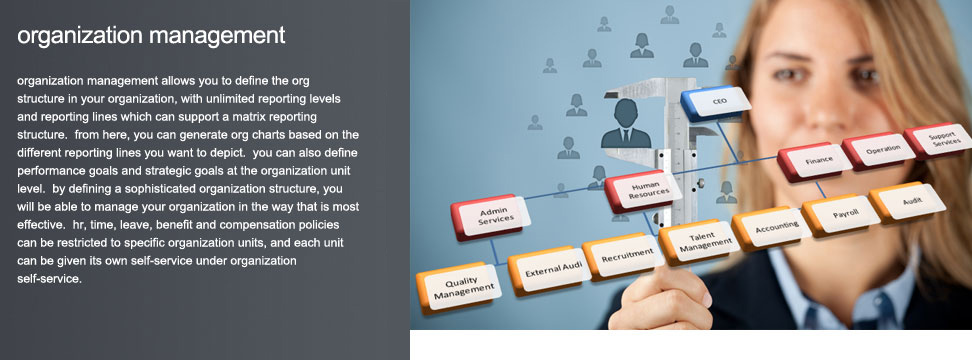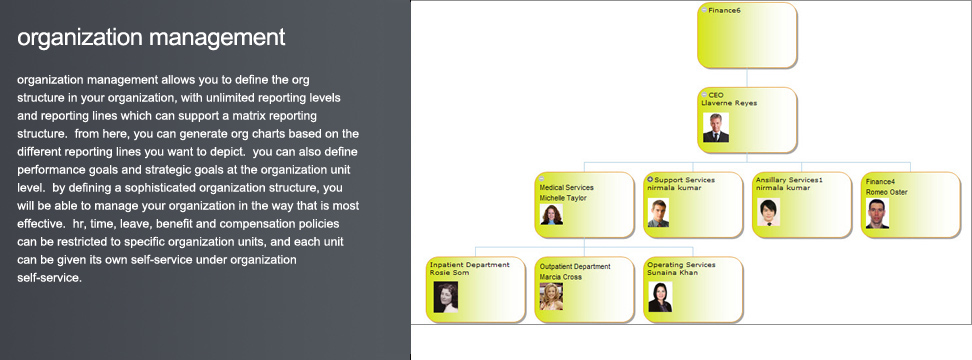 Organization Self Service |
Interact HRMS Organization Management Module Overview
The Interact HRMS Organization Management module provides a robust framework for defining and managing the structure of an organization. This module allows users to create a detailed, customized representation of their organizational hierarchy, which is essential for effective reporting, payroll distribution, workflow approvals, and performance management. Designed to support any number of employers and organizational units, the Organization Management module can accommodate the complexities of multi-entity enterprises as well as single organizations with diverse internal structures. By organizing the workforce into a logical, well-defined hierarchy, organizations gain greater control over their operations, enabling improved decision-making and streamlined processes.
This module goes beyond the basics of organizational structure by allowing users to define various classifications, reporting relationships, and goals at each level. The system supports an unlimited number of reporting lines and levels, ensuring that every organization can model its unique structure accurately. Whether an organization is structured by divisions, departments, branches, or projects, this module provides the flexibility to capture and visualize every detail. An organization chart is generated based on the data entered, giving stakeholders a clear view of reporting relationships and the overall structure. Additionally, the module supports multi-dimensional reporting lines, allowing users to set up administrative, functional, and technical reporting relationships as needed.
Flexible Organization Structure Definition
The Organization Management module enables users to define the structure of their organization in multiple, user-defined ways. Each organization unit can be classified according to various types, such as company, branch, division, department, section, project, or any custom classification that meets the organization’s needs. This flexibility allows organizations to create a hierarchical model that accurately reflects their operational and management structure.
Within each organization unit, users can further classify units by groups, work unit types, and other custom categories. This granularity ensures that every unit, from high-level divisions to individual projects, is represented within the system. By offering an unlimited number of organization units and classifications, the module accommodates the needs of both small organizations with straightforward hierarchies and large, complex enterprises with multiple levels of management and reporting.
Multi-Employer and Multi-Database Support
Interact HRMS is designed to support multiple employers within a single database or across separate databases for each employer. This capability is especially beneficial for organizations that operate as part of a larger corporate group or have subsidiaries across various regions. By enabling each employer to define its structure within the same system, the module simplifies cross-organizational reporting and management. Organizations can view each employer’s structure individually or analyze data across multiple employers when needed, facilitating efficient management of diverse business entities.
The ability to define multiple employers within the module also allows for shared services across organizations, streamlining HR, finance, and administrative functions within a single system. This capability supports both centralized and decentralized management structures, providing organizations with the flexibility to manage their workforce as a cohesive unit or as independent entities.
Comprehensive Organization Chart Visualization
Once the organizational structure is defined, the module generates an organization chart that visually represents the hierarchy and reporting relationships within the organization. This organization chart is automatically created based on the data entered, and it updates dynamically as changes are made. The chart provides a clear visual representation of each organization unit’s position relative to others, making it easy for stakeholders to understand the flow of authority and reporting lines.
The organization chart is more than just a visual tool—it also serves as the foundation for various HR processes. By mapping out reporting relationships, the chart ensures that workflows and approvals follow the correct paths, aligning with the organization’s defined hierarchy. The organization chart also supports HR functions such as performance management, where the reporting structure is crucial for setting goals, managing KPIs, and tracking accountability.
Unlimited Reporting Relationships and Levels
The Organization Management module supports an unlimited number of reporting relationships and levels, providing organizations with the flexibility to model complex hierarchical and matrix structures. Each organization unit can establish multiple reporting lines, including administrative, functional, and technical reporting relationships, or any other user-defined type of reporting line. This capability is essential for organizations with matrix structures, where employees may report to multiple managers depending on their function or project.
Each reporting relationship includes a start and end date, as well as the option to define a manager with specific authority and scope. This feature allows organizations to manage temporary reporting relationships, such as those associated with projects or short-term assignments, without disrupting the overall organizational hierarchy. By offering detailed control over reporting lines, the module enables organizations to maintain clear accountability and authority at every level.
Organization Structure for Reporting and Costing Purposes
The defined organization structure serves as a foundation for reporting, enabling organizations to generate reports based on specific units or groups of units. This structure is crucial for departments such as HR and finance, where reports are often needed at various levels of the organization, such as by division, department, or project. The Organization Management module ensures that users can filter reports by organization unit, providing targeted insights and facilitating data-driven decision-making.
In addition to reporting, the organization structure plays a vital role in payroll costing. When the module is used in conjunction with payroll management, payroll costs can be distributed by cost center, project, or activity, ensuring accurate financial tracking. This distribution allows organizations to align payroll costs with their operational structure, supporting budget management and enhancing financial transparency. By linking payroll costs to specific organization units, organizations gain visibility into spending patterns and can make adjustments to optimize resource allocation.
Foundation for Workflow Approvals and Reporting Lines
The organization structure defined within the module is integral to workflow approval processes. By establishing clear reporting lines, the module ensures that approvals for HR actions, such as leave requests, expense reimbursements, and job changes, are routed to the correct managers based on the hierarchy. This alignment between the organization structure and workflow approvals promotes accountability, as managers receive approval requests for employees within their reporting lines.
Additionally, the structure supports effective communication and management, as employees understand their reporting relationships and the flow of authority within the organization. This clarity helps improve operational efficiency, reduce errors in approval processes, and maintain compliance with organizational policies.
Position Budget Control for Organization Units
Each organization unit within the module can be controlled by a position budget, enabling organizations to manage staffing levels based on an approved budget. This feature restricts hiring to vacant, budgeted positions, ensuring that each unit operates within its financial limits. By linking staffing decisions to budgeted positions, organizations can control labor costs, maintain compliance with budgetary guidelines, and prevent unauthorized hiring.
For units that do not require strict budget control, the module offers the option for open hiring, allowing for flexibility in departments with fluctuating staffing needs. This flexibility accommodates both tightly controlled and dynamic hiring environments, enabling organizations to meet their operational requirements while maintaining budget discipline.
Organization Unit Self-Service Capabilities
The module includes self-service capabilities for each organization unit, empowering managers and employees to access relevant HR information and manage certain functions independently. These self-service features allow unit managers to handle tasks such as updating unit details, reviewing budget allocations, and managing performance goals directly within the system. By enabling self-service, the module reduces the administrative burden on HR and provides unit managers with the tools they need to oversee their teams effectively.
Performance and Strategic Goals for Each Organization Unit
Each organization unit within the module can be assigned performance and strategic goals, supporting performance management and KPI tracking across the organization. These goals can be customized for each unit, aligning with the organization’s overall objectives while addressing the unique needs of each department or project. By associating goals with specific units, the module provides a structured approach to performance management, ensuring that every part of the organization contributes to the company’s success.
Performance and strategic goals are integral to KPI management, as they establish the benchmarks against which each unit’s performance is measured. By linking goals to organization units, the module ensures that managers and employees have clear targets to strive for, promoting accountability and encouraging continuous improvement across the organization.
Summary: Interact HRMS Organization Management
The Interact HRMS Organization Management module is a comprehensive solution for defining and managing organizational structures. Key benefits include:
- Flexible Organization Structure Definition: Define a customized hierarchy with classifications such as company, branch, department, and project.
- Multi-Employer and Multi-Database Support: Manage multiple employers within a single system, supporting diverse corporate groups.
- Comprehensive Organization Chart Visualization: Generate dynamic organization charts to map reporting relationships visually.
- Unlimited Reporting Relationships and Levels: Support complex hierarchical and matrix structures with multi-dimensional reporting lines.
- Reporting and Costing Integration: Align organizational units with reporting and payroll cost distribution for better financial control.
- Foundation for Workflow Approvals: Define reporting lines to streamline approval processes and enhance accountability.
- Position Budget Control: Control hiring based on approved budgeted positions or allow open hiring where flexibility is required.
- Organization Unit Self-Service: Empower unit managers with self-service tools to oversee HR and financial details.
- Performance and Strategic Goals: Set and track performance goals for each organization unit to support KPI management.
By combining these features, the Organization Management module enables organizations to create a structured and well-managed hierarchy that supports financial control, reporting, workflow approvals, and performance management, ensuring operational efficiency and strategic alignment across the organization.Top of Form


